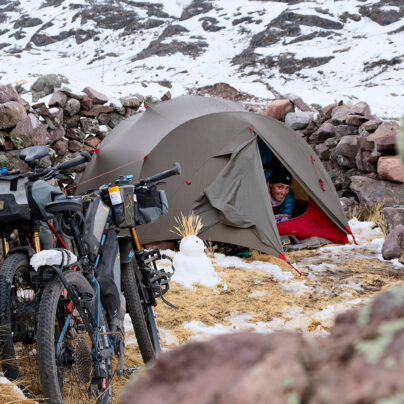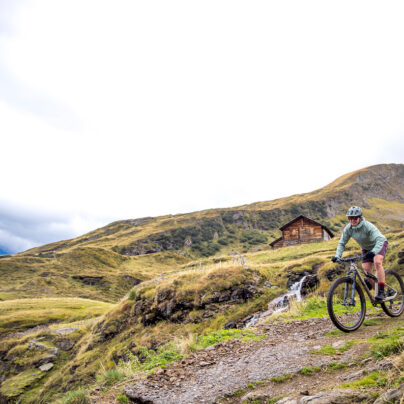Bernese Oberland: Summit to Sea
A Journey through Switzerland’s Bernese Oberland Region
Written by Anke Eberhardt // Photography: Johny Cook & Steve Ashworth // Film: Summit Fever Media
Produced in partnership with Switzerland Tourism and Bernese Oberland Region
The walkway to a different planet is 170m long and 100m high. At its feet lies a milky turquoise lake, quietly feeding a creek that only seconds later turns into a wild river underneath this walkway, known as the Triftbrücke. This ropeway seems to lead into a different world. Back in the old days, mountaineers could make their way past the valley by crossing the giant Trift Glacier. But as the ice stream retracted, the lake and river rose, making the gorge impassable. Today, the Triftbrücke is one of the longest and highest pedestrian bridges in the Alps. If you take one of the little red gondolas of the Triftbahn, it’s fairly easy to access the mountains, and the short hike to the bridge is something people even do in sandals. A quick glimpse of the glacier, a selfie for the ‘gram – many of the day visitors only cross the bridge to return right away and head back to the gondola. But for us, it’s the beginning of our Alpine exploration of the Bern region.
Located in the west of the country, Bern is the second-largest canton in Switzerland. Its territory has the largest span between north and south, reaching from the Jura Mountains all the way to the Alps. Switzerland is a dreamlike location for alpinists and some of the biggest attractions are found in the region of Bern. Its famous mountains like the Eiger, Mönch, and Jungfrau are household names. The latter is home to the highest railway station in Europe, and the infamous North Face of the Eiger needs no explanation.
Even if we won’t summit any of these rocky majesties today, crossing the Trift bridge feels like entering their kingdom. On the way there, we passed flocks of sheep, grass, trees, bushes, and other forms of greenery, but after the bridge we’re above the treeline, and the grey of the stones has taken over. With every step, the trail narrows, leading us high along the valley towards the glacier. Sometimes we have to jump over little streamlets, then cross metal ladders, and more and more often grab one of the bolted chains to climb higher. The clock is ticking and we’re the last people out here, making our way up to the Trifthütte (Trift hut) before the sun sets and the grey turns to black.





So far, we haven’t seen the hut yet. From here it looks as if the trail will lead directly to the frosty white of the glacier. As we approach, the ice stream grows, making us feel smaller. And then, right when it seems as if we could touch the surface of the glacier still high above us, the trail makes a sudden turn and we see the hut for the first time – built from heavy rocks, perfectly camouflaged in the surroundings. The red shutters and the Swiss flag are the only dots of colour in this parallel universe.
Thick lentil soup. Home-made bread. Tales from other hikers at the table. One little schnapps to cheer the day. OK, one more. Then, early bedtime. In the morning, the dozen mountain women and men in our dormitory rise before the sun and don head lamps to get going. For them, the Trift hut is a stopover on the way to the glacier. For us, it’s the first stage of our summit-to-sea adventure. What goes up, must come down, says the proverb. And, from 2,500m up high, we want to go all the way down to the lakes in the valley.
***
‘You have the feeling inside of you, but you’re not used to it, that’s why it feels unreal,’ Mark screams against the sound of the wind. And indeed, my brain understands that I’m flying, but it’s as surreal as a 3D animation. ‘It’s like a taste you never experienced before – the body needs to recognise it,’ Mark continues. Yes, paragliding is a first for my body, and my eyes are too busy to decide whether they want to look at the huge mountains around us or at the two insanely beautiful lakes below.
After exploring the high Alpine terrain of the Bernese Oberland, we make our way to Interlaken – the self-proclaimed European capital of adventure. Hanging in a paraglider seat doing loops above the postcard-worthy Lake Thun and Lake Brienz is not the place to dispute this title. Hiking, mountain biking, climbing – everything is possible here. And thanks to the high mountains around the town, Interlaken benefits from a microclimate that provides perfect thermal lifts for paragliding on more than 300 days a year. Only a handful of regions in the world are as fortunate, and flying is a fast way to make people happy.





Heavy hiking boots recently burdened my feet, but now they are lighter than ever, dangling high up in the air. While the previously misty weather matched the monochrome mood of the high Alpine rock, today’s blue skies are the perfect canvas for our bright paragliders. Up here, you’re just a small dot in the biggest possible picture. Circling along with warm currents, effortlessly rising and descending – that’s a taste of freedom.
The mighty river serves some of the best rafting in the Swiss Alps, and our ride starts underneath a true mountain eminence: the infamous Eiger North Face.
When my paddle dips into the clear surface of Lake Thun, we now find freedom in liquid form. Just a couple of hours ago we were flying above this perfect mountain lake to speed up our descent from the peaks. But why let the air take care of the whole commute when we’re seeking our final destination: the water? So, we board an inflatable raft and tackle the Lütschine, a river appropriately named after the Celtic word for ‘white’ or ‘shiny’. The mighty river serves some of the best rafting in the Swiss Alps, and our ride starts underneath a true mountain eminence: the infamous Eiger North Face. While this legendary wall looks down from above, there are Class III to IV rapids waiting below. With a force that only Mother Nature can unleash, the waters push our boat to the left, to the right, and then high up in the air.
We’re a toy for the river – and, every time we manage to manoeuvre our little ship from one rapid to the next, we enjoy the game even more. Adrenaline is high while we make our way down to the valley. And the passing surroundings with giant rock formations and lush forests provide the appropriate audience; here’s a mountain peeking up behind the trees after almost every twist of the river. What goes up, must go down – and it goes down fast and fun in the white water.



The powerful river chases the little red boat down to Lake Brienz. On its sibling lake at the other side of Interlaken we float gracefully on stand-up paddleboards, in perfect balance between the two sides. We have spent the last hour cruising along the north shore of Lake Thun, making our way in the sun’s sparkling reflections. We’ve been told that there’s a waterfall that plunges straight into the lake, and what could be a better finish for our trip from summit to sea than falling water?
It’s this feeling of irrelevance compared to nature’s size that we humans seek, and there are few places where you can experience it like the Bernese Oberland – from up high on the peaks all the way down to the crystal-clear waters.
As we approach the gigantic cliffs, we haven’t spoken for a while. The only sounds we hear are the miniature waves gently sweeping against our boards, and, every once in a while, a crow commenting on our fleet, until the silence is stifled by the roaring plunge of the cascade as we draw closer. Standing here on the water guessing at the height of the rocks makes me feel small again, as I had at the vast alpine glacier, or taking the bird’s view from the paraglider. It’s this feeling of irrelevance compared to nature’s size that we humans seek, and there are few places where you can experience it like the Bernese Oberland – from up high on the peaks all the way down to the crystal-clear waters. We went up, we came down, and every stage was so spectacular that it won’t be the last time for us.



Floating on our boards while the sun sets, we open our dry bags and pile Swiss cheese on walnut bread, decorating it with local honey. We’ve lost track of time. We’ll have to make our way back to the shore in the twilight. With every paddle stroke, the town on the horizon illuminates a little more, drawing pointy churches and picturesque wooden houses onto the fading sky, welcoming us back like a different planet. We put our head lamps on and cruise into the night.
Written by Anke Eberhardt // @anke_is_awesome
Photography by Johny Cook // @johny.cook
Film by Summit Fever Media // @sfm_films
Produced in partnership with Switzerland Tourism and www.madeinbern.com







